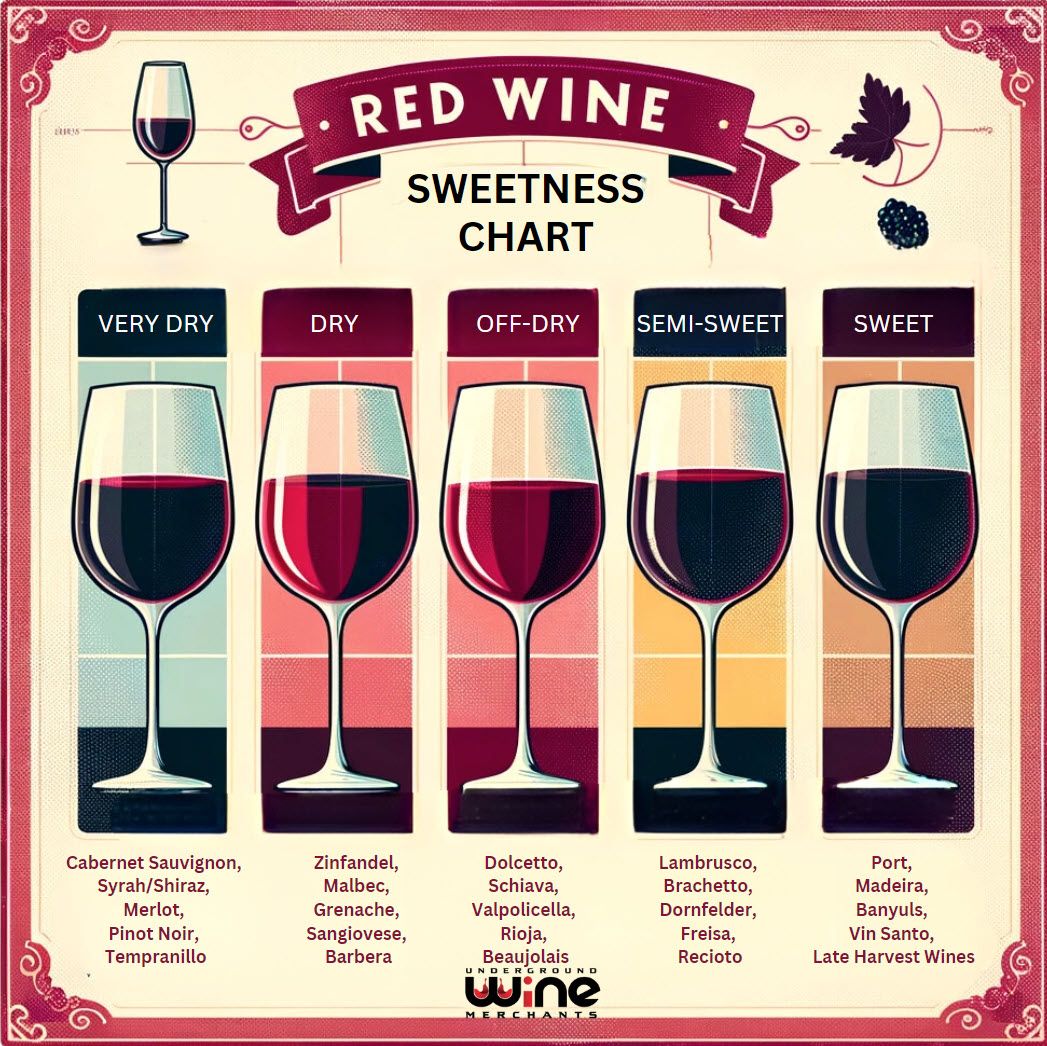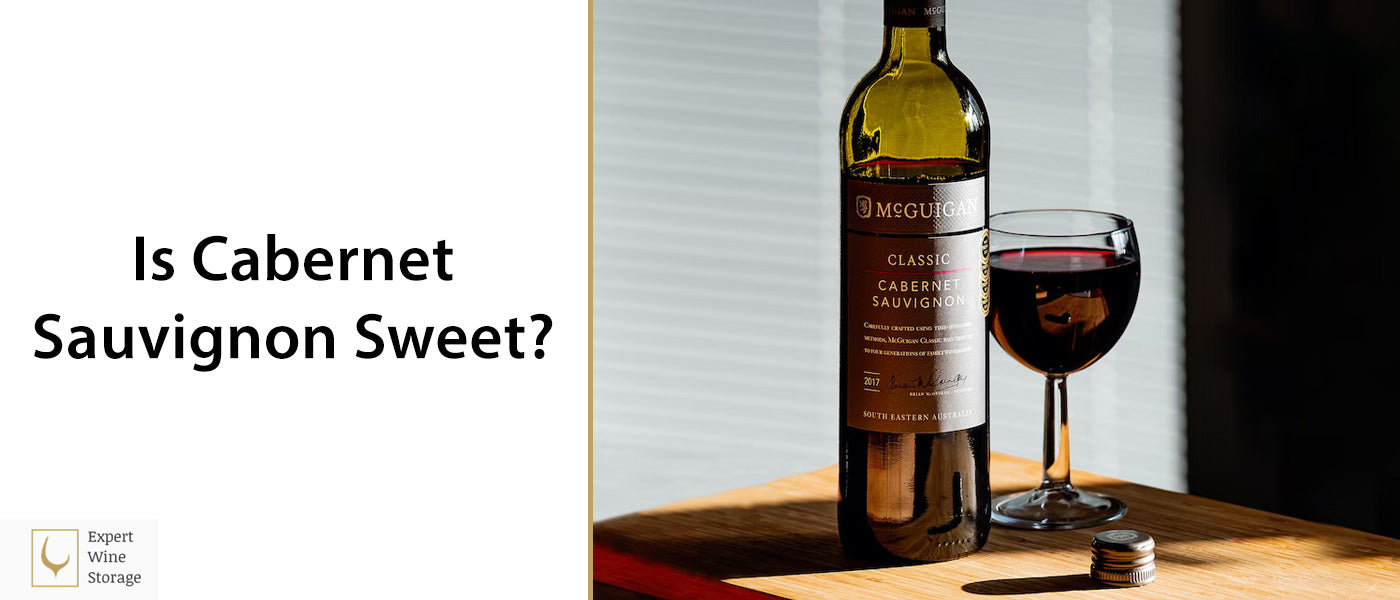
What Determines Sweetness In Wine
What Determines Sweetness In Cabernet Sauvignon
In Cabernet Sauvignon, the sweetness of the wine is primarily determined by the level of residual sugar remaining after fermentation. Residual sugar in wine is the natural sugars from grapes that remain unfermented, affecting the perceived sweetness. Higher levels of residual sugar result in a sweeter taste, while lower levels contribute to a drier profile. Grape ripeness and sugar levels during harvest play a crucial role in the amount of residual sugar in the wine. Riper grapes generally have higher sugar content, leading to a sweeter wine.
Factors Influencing Wine Sweetness
Various factors can influence the perceived sweetness of wine, with residual sugar being a key factor. Apart from residual sugar, fruitiness and tannin levels also impact the overall sweetness perception. Fruity flavors in wine can give the impression of sweetness, even if the residual sugar levels are low. On the other hand, tannins, which are compounds mainly found in grape skins, stems, and seeds, can contribute to a drier sensation in the wine, counteracting perceived sweetness.
In summary, the combination of residual sugar levels, fruitiness, and tannin content all contribute to the overall perception of sweetness in a wine, including Cabernet Sauvignon.
Understanding Cabernet Sauvignon Flavors
Tasting Notes And Aromas In Cabernet Sauvignon
In Cabernet Sauvignon, the flavor profile is intricate and can vary based on the wine’s origin and production methods. The wine typically exhibits a mix of flavors, which may include black cherry, black currant, cedar, tobacco, and mint. In regions with cooler climates, Cabernet Sauvignon may showcase fresher herbaceous notes like bell pepper, sage, and chamomile. This grape variety offers a diverse range of aromas and tastes that contribute to its complexity.
Characteristics Of Cabernet Sauvignon
Cabernet Sauvignon is known for being dry and full-bodied with medium-high tannins and medium acidity. It is revered for its diverse flavor profile, with some wines being fruity and sumptuous while others are more savory and smoky. The grape’s long-standing reputation as one of the most famous red wine varieties is well-deserved due to its versatility and ability to produce wines with rich and nuanced characteristics. Its complexity and depth make it a favorite among wine enthusiasts worldwide.
Cabernet Sauvignon Vs. Sweet Wines
Comparison To Sweet Wine Varieties
When comparing Cabernet Sauvignon to sweeter wine varietals, it is crucial to note that Cabernet Sauvignon is classified as a dry wine. This means that it contains minimal residual sugar, resulting in a lack of overt sweetness. In contrast, sweet wine varieties such as Moscato or Port possess higher levels of residual sugar, which contribute to their sweet taste profiles. The sweetness levels vary significantly between these wine types, with Cabernet Sauvignon leaning towards the drier end of the spectrum.
Distinguishing Cabernet Sauvignon From Sweet Wines
Cabernet Sauvignon stands out from sweet wines due to its characteristic dryness. The absence of significant residual sugar in Cabernet Sauvignon allows its other flavor components, such as black cherry, black currant, and cedar, to shine without being overshadowed by sweetness. This dry red wine is known for its full-bodied nature, medium-high tannins, and medium acidity, offering a complex and structured tasting experience that is distinct from sweeter wine varieties. Its versatility and ability to showcase diverse flavors make Cabernet Sauvignon a popular choice among wine enthusiasts seeking depth and complexity in their wine selections.

The Role Of Tannins In Cabernet Sauvignon
Tannins In Red Wine
Red wines like Cabernet Sauvignon contain tannins, which are naturally occurring compounds found in grape skins, seeds, and stems. Tannins are responsible for the dry mouthfeel and astringency in red wines, contributing to their overall structure and longevity. In Cabernet Sauvignon, tannins play a significant role in shaping the wine’s flavor profile and mouthfeel.
Impact Of Tannins On Wine Dryness
In Cabernet Sauvignon, tannins interact with proteins in saliva, leading to a drying sensation in the mouth. This dryness is often described as a puckering or gripping feeling on the palate, especially in young Cabernet Sauvignon wines. The presence of tannins helps balance out the rich fruit flavors in Cabernet Sauvignon, providing a sense of depth and complexity to the wine.
Cabernet Sauvignon Sweetness Perception
How Perception Affects Sweetness
When it comes to Cabernet Sauvignon, the perception of sweetness can vary among individuals. Factors such as personal preferences, sensitivity to taste, and previous tasting experiences play a role in how sweet or dry a particular wine may seem to different people.
Perceiving Sweetness In Wine Flavors
The fruit-forward notes often found in Cabernet Sauvignon can sometimes give the impression of sweetness, even in a dry wine. The ripeness of the grapes and the balance of flavors contribute to the overall taste profile, with sweetness being just one aspect. While the perception of sweetness in Cabernet Sauvignon is generally low, the focus is more on its intense flavors and complex structure.
The Role Of Tannins In Cabernet Sauvignon
Tannins In Red Wine
Red wines, including Cabernet Sauvignon, contain tannins that come from grape skins, seeds, and stems. These compounds are responsible for the dry and astringent mouthfeel commonly associated with red wines. In Cabernet Sauvignon, tannins are crucial for shaping the wine’s overall flavor profile and structure.
Impact Of Tannins On Wine Dryness
Within Cabernet Sauvignon, tannins interact with saliva proteins, creating a sensation of dryness in the mouth. This dry feeling, often described as puckering or gripping, is more pronounced in younger wines. Tannins help balance the wine’s fruitiness, adding depth and complexity to the overall tasting experience.
Pairing Cabernet Sauvignon With Food
Food Pairing Suggestions
Bold and full-bodied, Cabernet Sauvignon is a high tannin wine that pairs exceptionally well with rich hearty dishes. When considering food pairings for Cabernet Sauvignon, opt for fattier cuts of meat such as grilled steaks, braised short ribs, or beef stew. The wine also complements dishes featuring strong cheeses or herbs like rosemary and thyme. The intensity of the wine calls for robust flavors in food to create a harmonious balance on the palate.
Enhancing Culinary Experiences With Cabernet Sauvignon
Cabernet Sauvignon’s profile typically leans towards drier notes, with a focus on intense flavors and a complex structure rather than sweetness. Despite its low perceived sweetness, the fruit-forward characteristics of Cabernet Sauvignon can sometimes give the impression of sweetness due to the ripeness of the grapes. Tannins, the compounds responsible for the wine’s dry and astringent mouthfeel, play a crucial role in shaping the overall flavor profile of Cabernet Sauvignon, contributing to its depth and complexity. When serving Cabernet Sauvignon, ensure the wine is at just below room temperature (55° to 65° F) to bring out its best attributes and enhance the dining experience.
Overall, pairing Cabernet Sauvignon with the right foods can elevate both the wine and the dish, creating a memorable culinary experience that showcases the wine’s bold character and robust flavors.

Popular Misconceptions About Cabernet Sauvignon
Debunking Myths About Cabernet Sauvignon
Pairing Cabernet Sauvignon with Food
Common Misunderstandings Clarified
Food Pairing SuggestionsBold and full-bodied, Cabernet Sauvignon is a high tannin wine that pairs exceptionally well with rich hearty dishes. When considering food pairings for Cabernet Sauvignon, opt for fattier cuts of meat such as grilled steaks, braised short ribs, or beef stew. The wine also complements dishes featuring strong cheeses or herbs like rosemary and thyme. The intensity of the wine calls for robust flavors in food to create a harmonious balance on the palate.
Enhancing Culinary Experiences With Cabernet Sauvignon
Cabernet Sauvignon’s profile typically leans towards drier notes, with a focus on intense flavors and a complex structure rather than sweetness. Despite its low perceived sweetness, the fruit-forward characteristics of Cabernet Sauvignon can sometimes give the impression of sweetness due to the ripeness of the grapes. Tannins, the compounds responsible for the wine’s dry and astringent mouthfeel, play a crucial role in shaping the overall flavor profile of Cabernet Sauvignon, contributing to its depth and complexity. When serving Cabernet Sauvignon, ensure the wine is at just below room temperature (55° to 65° F) to bring out its best attributes and enhance the dining experience. Overall, pairing Cabernet Sauvignon with the right foods can elevate both the wine and the dish, creating a memorable culinary experience that showcases the wine’s bold character and robust flavors.
Exploring Red Wine Varieties Beyond Cabernet Sauvignon
Alternative Red Wine Options
When it comes to red wine, there is a myriad of options beyond Cabernet Sauvignon that offer unique flavors and characteristics. One such alternative is Cabernet Franc, a red wine grape known for its softer tannins and approachable nature. Unlike Cabernet Sauvignon, Cabernet Franc is typically ready to enjoy sooner and often produces lighter wines with hints of herbal scents. This versatile varietal can be a great introduction to exploring red wines beyond the more common choices.
Another red wine worth exploring is Merlot, which is known for its softer, velvety texture and ripe fruit flavors. Merlot can be a great choice for those looking for a smoother and more approachable red wine option. Its versatility allows it to pair well with a variety of foods, making it a popular choice for many wine enthusiasts.
Broadening Your Red Wine Palate
Shiraz (Syrah) is another red wine variety that offers a different flavor profile compared to Cabernet Sauvignon. Shiraz wines are known for their bold and spicy characteristics, with notes of black pepper, dark fruit, and smokiness. This varietal can add a new dimension to your red wine exploration, especially if you enjoy wines with a bit of a kick.
Malbec is yet another red wine variety to consider, especially for those who appreciate rich and full-bodied wines. Originating from Argentina, Malbec wines are known for their deep purple color, velvety texture, and flavors of dark fruits and spices. Malbec can be a great choice for those seeking a wine with robust flavors and a smooth finish.
In summary, exploring red wine varieties beyond Cabernet Sauvignon opens up a world of diverse flavors and experiences. From the softer tannins of Cabernet Franc to the bold spiciness of Shiraz, there are plenty of options to broaden your red wine palate and discover new favorites.
Conclusion And Recommendations
Summarizing Cabernet Sauvignon Sweetness
When it comes to exploring red wine varieties beyond Cabernet Sauvignon, there are several options worth considering. Cabernet Franc offers a softer tannin profile and herbal scents, providing a different experience from the boldness of Cabernet Sauvignon. Merlot presents a velvety texture and ripe fruit flavors, making it a popular choice for those seeking a smoother red wine. Shiraz (Syrah) introduces spicy notes and bold characteristics, while Malbec from Argentina brings rich, full-bodied flavors to the table. Understanding the diverse profiles of these red wines can enhance your wine tasting experience.
Recommendations For Enjoying Red Wine Flavors
To truly appreciate the flavors of different red wine varieties, it is recommended to take your time with each sip and savor the complexity. Cabernet Franc can be enjoyed for its softer tannins, while Merlot is perfect for pairing with a variety of foods. Shiraz (Syrah) offers a bold and spicy experience, while Malbec provides a rich and smooth finish. Exploring these red wine options will broaden your palate and allow you to discover new favorites. Experimenting with different food pairings can also enhance the overall tasting experience, making the most of the diverse flavors offered by red wines.
FAQ About Cabernet Sauvignon Sweet: Deciphering Red Wine Flavors
Q: Is Cabernet Sauvignon a sweet wine?
A: No, Cabernet Sauvignon is typically not a sweet wine. It is known for its bold, dry flavors with hints of dark fruits and tannins.
Q: What flavors can be found in Cabernet Sauvignon?
A: Cabernet Sauvignon commonly exhibits flavors of black currant, black cherry, plum, cedar, vanilla, and sometimes bell pepper or green olive notes.
Q: What food pairs well with Cabernet Sauvignon?
A: Cabernet Sauvignon pairs wonderfully with rich and savory dishes like grilled steak, roasted lamb, aged cheeses, and dark chocolate.
Q: How should Cabernet Sauvignon be served?
A: It is recommended to serve Cabernet Sauvignon slightly below room temperature, around 60-65°F (15-18°C), to allow its flavors to shine.
Q: Can Cabernet Sauvignon be aged?
A: Yes, Cabernet Sauvignon is known for its aging potential. Higher-quality bottles can be aged for several years, allowing the wine to develop more complex flavors.
Q: Does the region where Cabernet Sauvignon is grown affect its taste?
A: Yes, the region or terroir where Cabernet Sauvignon grapes are grown can greatly impact the taste of the wine, influencing factors such as fruit flavors, tannins, and overall style.

At Deep Woods Distillery, we try to put an essence of the Great Oregon Forest in each bottle of hand-crafted liquor we make. All of our spirits are made from scratch in Oakridge, Oregon, from select ingredients.